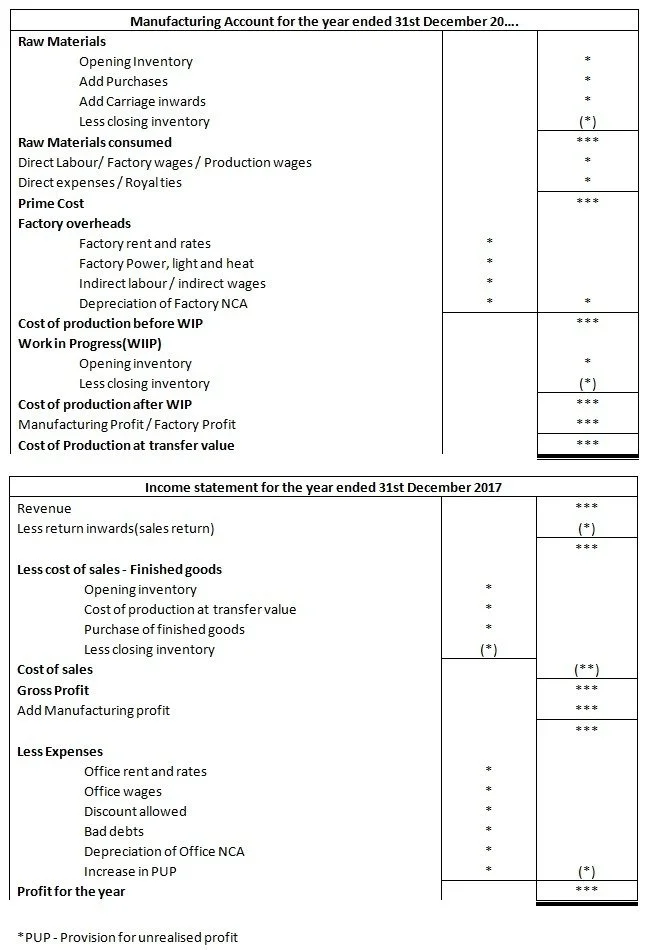Manufacturing Accounts
Some businesses may manufacture their own products instead of trading in finished goods. A manufacturing business is the most complete form of a business because it buys raw materials, converts them into finished items and then sells these items to its customers. Businesses that make their own products must prepare a manufacturing account as part of their internal financial statements. A manufacturing account shows the cost of running and maintaining the factory. It is prepared to calculate the cost of goods produced during the year and it is also known as the production account. Cost of production includes direct cost and indirect cost.
Direct costs are expenditure which can be economically identified with a specific cost unit. It has a direct relationship with number of output (units produced). For example:
- Direct materials.
- Direct labour/ direct wages/ factory direct wages/ factory direct labour/ manufacturing wages.
- Direct expenses (example: royalties)
The total of the direct cost is termed as prime cost.
Indirect costs are factory expenses that are not directly related with the final product. It is commonly termed as factory overheads and is incurred in running the operation of the factory. Indirect cost does not vary with the level of output. Whatever be the level of production, indirect cost remains the same.
Example of factory overheads:
- Factory rent and rates
- Factory machinery’s depreciation
- Factory insurance
- Factory supervisor's salary
- Indirect materials
- Indirect labour
- Indirect wages
- Factory light and heat
- Depreciation of Factory NCA
Items not included in the manufacturing account but treated as an expense in the income statement:
- Office rent and rates
- Office insurance
- Sales staff wages
- Carriage outwards
- Discount allowed
- Depreciation of office non-current assets
- Administrative, selling and distribution cost
- Finance cost
- General expenses, sundry expenses, advertising cost
- Bad debts and provision for doubtful debts
Inventories in Manufacturing Businesses
| Type of inventory Raw Materials | Opening inventory Manufacturing | Closing inventory Manufacturing Statement of financial position |
| Work in progress | Manufacturing Account | Manufacturing Account Statement of financial position |
| Finished goods | Income statement | Income statement Statement of financial position |
Note
Closing inventories must be recorded at cost and not at transfer value in the statement of financial position
Factory profit
Manufacturing businesses usually transfer finished goods from the manufacturing account to the income statement at market value (wholesale price) to evaluate how efficiently the factory is operating. The market value or transfer value is obtained by adding a percentage of profit to the cost of production. This profit is known as factory profit/ manufacturing profit. Factory profit (loss) is the difference between the market price (the price the business has to pay if the goods produced were to be purchased in the wholesale market from other suppliers) and the cost of producing these goods. Factory profit may be calculated as follows:
Factory profit
= mark up × cost of production
= margin × cost of production at transfer value (TV)
= cost of production at transfer value – cost of production
Factory profit must be added with cost of production in the manufacturing account and recorded as an income in the income statement.
Provision for unrealised profit (PFUP)
Many businesses transfer finished goods at market value. Therefore closing inventory of finished goods will be valued at market price and will include an element of factory profit. In that case it is necessary to provide for the element of manufacturing (unrealised) profit which is included in their valuation since it is against the prudence concept and realisation concept. Therefore the factory profit must be adjusted for any unrealised profit and inventories of finished goods must be disclosed at cost (not at transfer value). For this purpose a provision for unrealised profit is set up and maintained. Provision for unrealised profit may be calculated as follows:
If inventory of finished goods is at cost:
PFUP = [ Manufacturing profit / Cost of production ] × closing inventory of finished goods at cost
= mark up × closing inventory of finished goods at cost
If inventory of finished goods is at transfer value:
PFUP = [ Manufacturing profit / Cost of Production at TV ] × Closing inventory of FG at TV
= margin × closing inventory of finished goods (FG) at transfer value (TV)
Note:
- Provision for unrealised profit at start is calculated using opening inventory of finished goods and at end using closing inventory of finished goods.
- Provision for unrealised profit must be deducted from inventory of finished goods at transfer value (TV) in the statement of financial position.
Format
